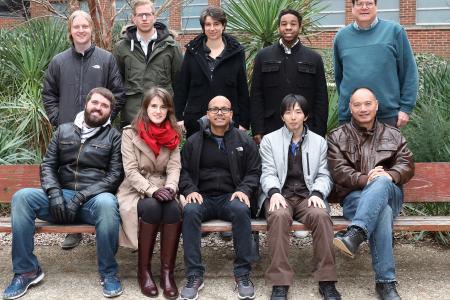Senior Investigator Research Interests
Dr. Brooks' research group have been involved in CHARMM development and oversight for more than 30 years. His research efforts have involved the development of new methods to assist the interpretation of experiment, for integrating multiple computational models into a single (multiscale) computation, the development of methods for normal mode analysis of large bio-macromolecules, new enhanced sampling methods, new restraint methods, and techniques for finding reaction pathways in complex systems. All of these developments are integrated into CHARMM, a complete tool for complementing and enhancing experimental research.
Projects
- Molecular Dynamics Simulations of Biological Macromolecules Molecular dynamics simulations are used to predict or explain function or structures of peptides and proteins and their substrates.
- Development of Theoretical Methods for Studying Biological Macromolecules New theoretical techniques are developed and characterized. These efforts are usually coupled with software development, and involve the systematic testing and evaluation of new ideas.
- Three-dimensional Structures of Biological Macromolecule We use computational techniques with experimental data to determine the three-dimensional structures of biological macromolecules and molecular assemblies. Experimental techniques include electron microscopy, electron tomography, NMR spectroscopy, and CD spectroscopy.
- Development of Advance Computer Hardware and Software We develop and refine parallel computing techniques for macromolecular simulation and build suitable hardware required to efficiently execute it.
Software
High Performance Computing Section
The High Performance Computing Section of the Laboratory of Computational Biology is part of the Biochemistry and Biophysics Center Division of Intramural Research National Heart, Lung, and Blood Institute of the National Institutes of Health. This Section is a group of researchers who support and maintain the LoBoS cluster that allows scientists in the laboratory to use high-performance computing to investigate biological systems by using molecular dynamics. This Section is lead by John Legato.
Meet the Team

Bernard Brooks, Ph.D.
Bernard Brooks earned an S.B. in chemistry from Massachussets Institute of Technology in 1975 and a Ph.D. in chemistry from University of California, Berkeley in 1979. He did his postdoctoral at Harvard University under the supervision of the Dr. Martin Karplus and he joined the NIH in 1990 as a staff fellow in the Division of Computer Research and Technology at the National Institutes of Health. In 1998 we become the Chief of Molecular Graphics and Simulation Section of the Laboratory of Structural Biology and in 1998 he occupied the position of Chief of the Computational Biophysics Section of the Laboratory of Biophysical Chemistry of the National Heart, Lung and Blood Institute. Since 2005 he is the Chief of the Laboratory of Computational Biology at the NHLBI. In 2008 he receive the NHLBI Oustanding Mentor Award and in 2010 he got the NIH Merit Award in recognition of defining the needs of supercomputing power to meet contemporary scientific needs at NIH.
Contact the lab
Félix Aviat, Ph.D.

Ada Chen

Ana Damjanović, Ph.D.
Phillip Hudson, Ph.D.
Mahdi Ghorbani

Jiyeon Min

Samarjeet Prasad

Andy Simmonett, Ph.D.




